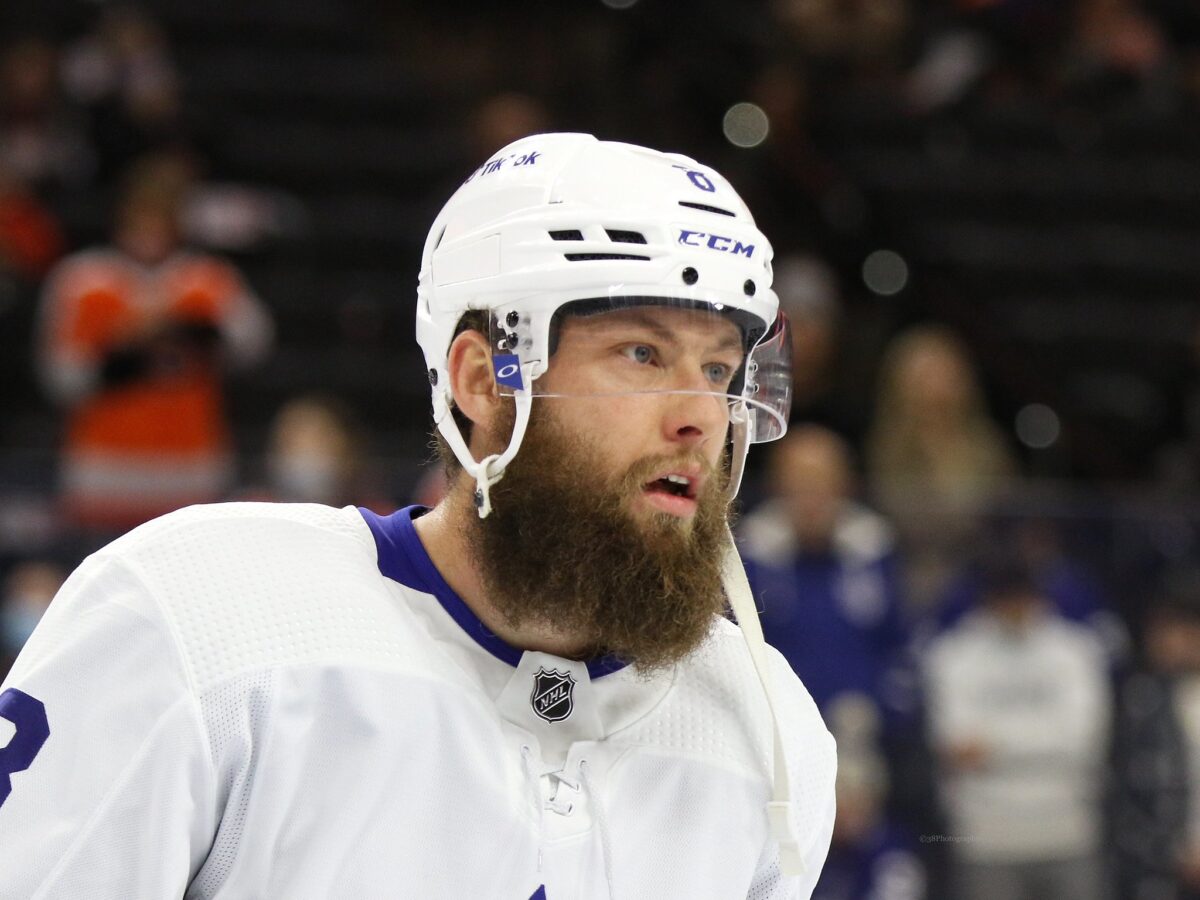Recently we wrote about Justin Holl’s and Jake Muzzin’s struggles this season. The statistical numbers showed that, for the first time since becoming a Leafs regular, Holl has been an actual negative statistic.
Related: Maple Leafs Not Getting What They Need From Muzzin or Holl
In that article we wrote, “By the eye test, (we thought) that the Maple Leafs’ defense was better with Dermott in and Holl out.” The question we want to answer here is, using the same six analytic categories tracked by naturalstattrick, how do Travis Dermott and Justin Holl compare?

If we put the two player’s numbers side-by-side and compare the same five-on-five stats we used previously, this is what we see:
| Statistic | Justin Holl | Travis Dermott |
| Percentage of Shot Attempts | 44.8% | 51.2% |
| Percentage of Actual Shots | 44.0% | 50.4% |
| Percentage of Scoring Chances | 45.1% | 55.5% |
| Percentage of High Danger Chances | 45.3% | 51.9% |
| Percentage of Actual Goals | 45.5% | 52.6% |
| Percentage of Expected Goals | 46.7% | 56.0% |
| Overall Average | 45.2% | 52.9% |
[Note: Anything over 50% is considered a positive, while anything less than 50% is a negative.]
Analyzing the Comparisons
When we look at the findings, we can see that Dermott is a positive in every category. Holl is a negative in every category. That seems simple enough on the face of it; however, other factors are involved that must be considered. For example, the numbers don’t show Holl’s Quality of Competition, which has been much more difficult than Dermott’s. The majority of Holl’s minutes are spent on the ice against the other team’s top two lines. Typically, Dermott’s are utilized against the opposition’s bottom six.
Related: Oilers History: The Paul Coffey Effect
The findings also fail to take into consideration the quality of either player’s line-mates. This area is less cut and dried than the quality of competition. Holl usually plays behind the Maple Leafs’ best forwards. At five-on-five play, when Holl’s on the ice it is usually with either Auston Matthews and Mitch Marner or John Tavares and William Nylander. Such partnerships should positively affect his numbers. As well, Holl’s more regular partner, Jake Muzzin, is also struggling this season. That fact would have the effect of dragging Holl’s numbers down.

Dermott, on the other hand, would rarely get on the ice with any of the Maple Leafs’ top-four forwards. However, he often played alongside Rasmus Sandin. Sandin’s had great analytics this season. We’ve covered that topic earlier.
Another factor that has a strong effect on a player’s numbers is zone starts. Holl has started 68% of his shifts in the defensive zone. Dermott has started 57% of his shifts in the offensive zone.
Related: Capital City Challenge Player Awards
Because the game is played mostly five-on-five, the numbers we looked at are five-on-five numbers. If we look at other situations, we see that Holl has spent 43 minutes (an average of 2:30 minutes per game on the penalty kill. Dermott has only played only 5:30 minutes in total on the penalty kill (or about 30 seconds each game). Neither player sees the ice on the power play.
You may also like:
- Maple Leafs Should Keep Murray as Third Goaltender
- Flames & Maple Leafs Trade History Revisited
- 3 Players the Maple Leafs Could Target on a PTO
- NHL Rumors: Oilers, Maple Leafs, Capitals, Kuznetsov News
- Maple Leafs Should Target Evgeny Kuznetsov as Reclamation Project
Despite the disparity between the stats posted by each player, we cannot state that one player is definitely better, or worse than the other. We can state that Dermott has been more successful in the situations he’s been placed in than Holl has been in the different situations he’s been placed in. (from “Keefe’s faith in separated Muzzin, Holl remains as Leafs D-men look to rebound,” Terry Koshan, Toronto Sun, 10/12/21).
What We Would Like to See
We believe Dermott has earned some tougher usage. We know that Muzzin is the driver of the Muzzin/Holl pairing. Although we didn’t have the time or space to show it here, Holl’s play does drop off drastically when he’s used away from Muzzin.

That leads us to ask, would Muzzin have the same positive effect on Dermott’s game than he has on Holl’s? On the same note, could having a speedier partner in Dermott help Muzzin get his game back to where it was before this season. We believe this is an area we’d like to see the Leafs explore further. Both players – Muzzin and Dermott – might positively impact each other’s play.
There’s also the future to consider. Both players are signed for another season, Holl at $2 million and Dermott at $1.5 million. Holl turns 30 in January. Dermott turns 25 just before Christmas. Holl is approaching the downward slope of his career. Dermott is just coming into this prime.
Related: Remembering Borje Salming: “King” of Maple Leafs’ Defensemen
The Maple Leafs presently have $5.4 million in extra cap space because players have been placed on the LTIR. Hopefully, the team will soon get a full and healthy roster. If and when that happens, moves must be made to keep the Maple Leafs under the salary cap. Although we don’t expect Holl or Dermott to be a player who will be moved at this point, it’s been rumored that Dubas has been willing to talk to other teams about the two players.
The question is “If you were Dubas and had to move either Dermott or Holl, who would you move?” Although we believe that’s a question for after this season is completed, for right now we believe it’s time for play Muzzin and Dermott on the same defensive pairing.
[Note: I want to thank long-time Maple Leafs’ fan Stan Smith for collaborating with me on this post. Stan’s Facebook profile can be found here.]